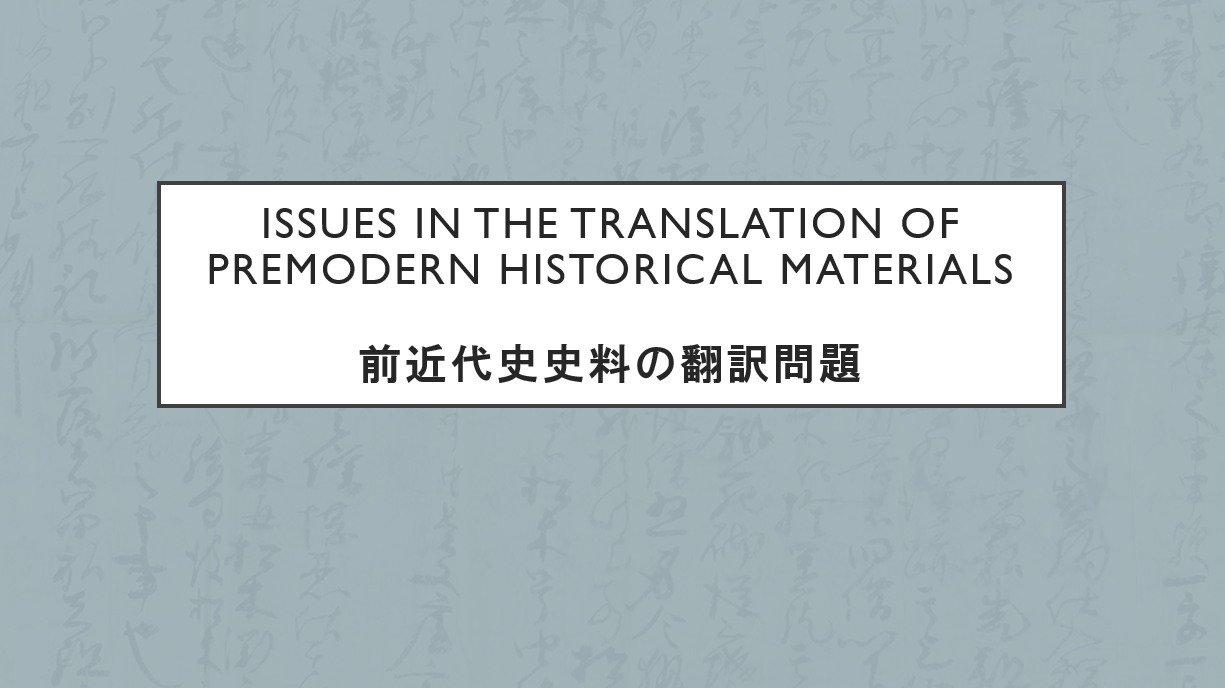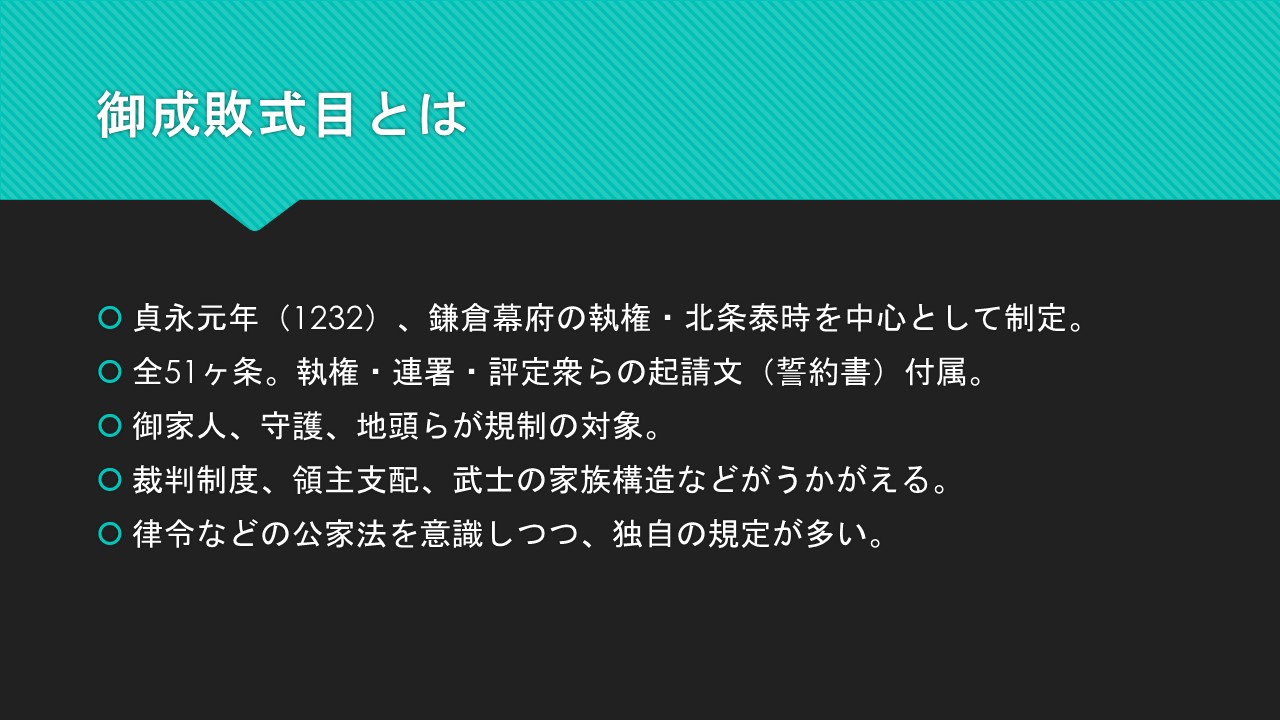(English follows Japanese.)
2020年6月7日・21日に、日本史史料英訳ワークショップの第一回・第二回が開催されました。講師として、イェール大学のポーラ・カーティス氏(日本中世社会経済史)をお招きしました。
第一回では醍醐寺文書を取り上げ、日本中世宗教史専門の橘悠太氏(奈良文化財研究所)と黄霄龍氏(東京大学)、第二回では御成敗式目を取り上げ、日本中世法制史専門の木下竜馬氏(東京大学史料編纂所)と佐藤雄基氏(立教大学)が史料の読み下し・現代語訳を担当しました。
以下、ワークショップの内容を簡単にまとめます。
【醍醐寺文書の回】
・英語圏における日本史史料翻訳の現状
・検討史料:康暦元年(1379)「足利義満御教書」、貞和三年(1347)「足利直義書状案」、応永三十四年(1427)「僧正隆寛付法状」など
・主たる論点:「護持」の英訳はdefenseかprotectionか、密教儀礼で使う「道具」はimplementかtoolかinstrumentか、文書名の訳し方は古文書の様式と機能いずれに即すか、など。

【御成敗式目の回】
・John Carey Hall(イギリスの外交官)による御成敗式目の英訳とその影響
・検討史料:第5条「諸国地頭、令抑留年貢・所当事」、第41条「奴婢雜人事」など
・主たる論点:「年貢」、「所領」、「知行」、「奴婢」の英訳など。

二回とも約27名くらいの参加を得られました。西洋史・東洋史の方も参加してくださり、日欧の土地制度・訴訟制度、日本の「奴婢」は「奴隷」なのか等についても議論が盛り上がりました。
また、参加者からは、①単語・語句レベルでの訳語を、日本と海外の研究者が一同に会して検討することで、日本史史料(そして非西欧圏の史料全般)を英訳するときに出てくる本質的共通課題が見つかる場となる、②こうした議論を史学史的にレベルアップし、日本と海外の両方の研究者にとっての意味を再確認する場になっていくことを願っている、との声も寄せられました。
まだ試運転段階ですが、企画・運営側として、本ワークショップが参加者の皆さんにとって有意義なものになっていることを知り、心から喜んでおります。秋以降は近世、近代の回なども予定していますので、どうぞ、続報を楽しみにお待ちください。
問い合わせ先:黄霄龍 hxiaolong[at]g.ecc.u-tokyo.ac.jp
ーーーーーーーーー
On June 7 and June 21, 2020, the Historians’ Workshop held workshops on the interpretation and translations of Japanese historical materials. We invited Paula R. Curtis (Yale University), a specialist in Japanese medieval social and economic history), as our lecturer.
In the first session, we discussed fourteenth-century documents related to Daigoji Temple. TACHIBANA Yuta (Nara National Research Institute for Cultural Properties) and HUANG Xiaolong (The University of Tokyo), who specialize in the history of medieval Japanese religion, prepared the medieval Japanese readings and modern Japanese interpretations, which were distributed to workshop participants. In the second session, we discussed the Kamakura period legal code Goseibai shikimoku. KINOSHITA Ryoma (Historiographical Institute, The University of Tokyo) and SATO Yuki (Rikkyo University), who specialize in the history of legal systems in medieval Japan, presented their readings, interpretations, and insights into the translations of some terms found in the documents.
The following is a brief summary of these sessions.
【A selection of Daigoji Materials】
・Issues in the translation of premodern historical materials
・Documents discussed: Ashikaga Yoshimitsu Directive (1379), Ashikaga Tadayoshi Letter Facsimile (1347),High Priest Ryūkan Letter of Transmission (1427) .etc.
・Some points of interest: the translation of 護持 as “defense” or “protection、” how to capture the nuance of the term 道具 in religious settings (debating the terms “implement,” “tool” or “instrument”)、how to translate titles of documents provided by scholars that may be interpretative (based on style or function), etc.
【A selection of Goseibai shikimoku】
・John Carey Hall’s 1906 translation and its influence on present-day research and teaching
・Documents discussed:Article 5 “Regarding land stewards (jitō) of various provinces withholding the annual tribute (nengu) and land taxes (shotō)”; Article 41 “Regarding bound servants (nuhi zōnin)”, etc.
・Some points of interest:considerations in the translation of core terms such as 年貢, 所領, 知行, 奴婢, etc.
We had about 27 participants in each session. Attendees included scholars of Western history and Eastern history, and discussions were held on the differences between land systems and legal systems in medieval Japan and Europe, and the complications that arise when dealing with Japanese terms such as “奴婢,” which is sometimes translated as “slave,” and sometimes as “bound servant.”
Participants also expressed their hopes that (1) by having Japanese and foreign researchers discuss translation together at the word/phrase level we will be able to find common issues that emerge when translating Japanese historical materials (as well as all the non-Western historical materials) into English, and that (2) we might be able to elevate these discussions to a historiographical perspective and reconsider their significance to both Japanese and foreign researchers.
We are still experimenting with the workshop’s format, but organizers are very pleased to know that it was meaningful for all the participants. We are also planning to hold Edo and modern sessions this fall and look forward to seeing you all next time!
For more information, please contact at HUANG Xiaolong (hxiaolong[at]e.u-tokyo.ac.jp).
